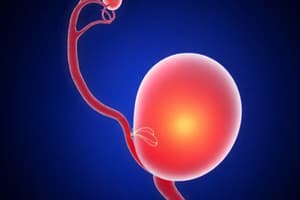Podcast
Questions and Answers
توجد خلايا Leydig حول الأوعية الدموية في الخصية.
توجد خلايا Leydig حول الأوعية الدموية في الخصية.
False (B)
التستوستيرون يلعب دوراً هاماً في تطور الأعضاء التناسلية الداخلية والخارجية عند الاناث.
التستوستيرون يلعب دوراً هاماً في تطور الأعضاء التناسلية الداخلية والخارجية عند الاناث.
False (B)
الدرزات الميزونفريكية (Wolffian) تتحول فيما بعد إلى القنوات التناسلية الذكرية الأساسية.
الدرزات الميزونفريكية (Wolffian) تتحول فيما بعد إلى القنوات التناسلية الذكرية الأساسية.
False (B)
خلايا Sertoli تفرز هرمونًا مضادًا لهرمون Mullerian.
خلايا Sertoli تفرز هرمونًا مضادًا لهرمون Mullerian.
تقوم القنوات Mullerian بتطور الجهاز التناسلي للذكور.
تقوم القنوات Mullerian بتطور الجهاز التناسلي للذكور.
Flashcards are hidden until you start studying
Study Notes
Overview
At the start of human life, the germ cells from the yolk sac attach to the indifferent gonads and initiate the formation of primitive sex cords. The presence of the SRY gene in males determines the development pathway, leading to the formation of testes. Meanwhile, in the absence of the SRY gene, the female embryo develops ovaries.
The Indifferent Stage
In the earliest stages of gonadal development, the gonads are undifferentiated, containing neither oocytes nor sperm. This stage is referred to as the 'indifferent stage', where the gonads lack specific male or female traits. It is essential to note that this stage is not truly neutral since the eventual differentiation into male or female gonads depends on genetic and hormonal factors. The indifferent stage is marked by the attachment of primordial germ cells from the yolk sac to the gonads and the subsequent generation of a pair of longitudinal ridges known as genital ridges.
Primitive Sex Cords
As the indifferent gonads continue to develop, the epithelium of the genital ridges proliferates and penetrates the underlying mesoderm to form primitive sex cords. These cells surround the primordial germ cells and help establish the initial structure for the developing gonads. The combination of germ cells and primitive sex cords forms the indifferent gonad, from which development into either testes or ovaries will eventually take place.
Differentiation into Testes
In males, the presence of the SRY gene (found on the Y chromosome) stimulates the development of the primitive sex cords to form testicular (medullary) cords. Surrounding the testis cords are the Leydig cells, which begin producing testosterone in the eighth week of development. This hormone plays a crucial role in driving the differentiation of the internal and external genitalia. Specifically, testosterone influences tissues that are bipotential to become male reproductive structures. For example, with exposure to testosterone, cells that could potentially become either the glans penis or the glans clitoris form the glans penis.
Testosterone also promotes the development of the mesonephric (Wolffian) ducts, which eventually give rise to the primary male genital ducts, including the epididymis, vas deferens, and seminal vesicles. On the other hand, the paramesonephric (Mullerian) ducts make way for the development of the female reproductive system, with the ducts degenerating in the presence of anti-Mullerian hormone produced by Sertoli cells in the testes.
Conclusion
The development of the male reproductive system begins with the formation of indifferent gonads, followed by the differentiation into testes driven by the presence of the SRY gene. The secretion of testosterone by Leydig cells triggers various processes, such as the development of the mesonephric (Wolffian) ducts and the transformation of cells into specialized male reproductive structures. Understanding these complex processes helps us appreciate the intricate nature of embryonic development and sexual differentiation.
Studying That Suits You
Use AI to generate personalized quizzes and flashcards to suit your learning preferences.




